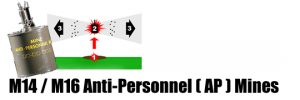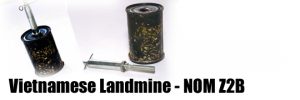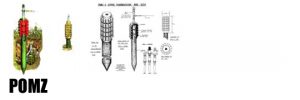
M14 / M16 Anti-Personnel (AP) Mines
Anti-Personnel (AP) mines can kill or incapacitate their victims. They can be fused by pressure, wire, or command detonation and contain a blast, bounding-fragmentation, or direct-fragmentation warhead.
DESCRIPTION:
The M14 is a non-metallic, blast-type AP mine consisting of a main charge of tetryl (1 ounce). The mine is cylindrical in shape, 2-3/16 inches in diameter and 1-9/16 inches high weighing approximately 3-1/2 pounds. The M14 is not designed to kill, but to incapacitate. The M14 AP mine has been modified by gluing a metal washer to the bottom of the mine. The modification was directed to improve the detectability of the mine. Unmodified mines are not authorized for use by US forces.
The M16A2 is a cylindrical, steel bodied, bounding A personnel mine which is designed to wound or kill by fragmentation. The mine resembles a large tin can, it has a crimped upper edge and a threaded fuse cavity offset from centre on top of the body. A tubular pronged fuse (M605 pull/pressure) is screwed into the cavity and the mine is ready for use. Pull of 1.5 kg on a tripwire or pressure of 3.5 kg on one of three prongs on top of the M605 actuates the mine. When actuated the mine bounds approximately 1.5 meters into the air and explodes, scattering fragmentation to a radius of 30 meters. The mine has an emplaced life expectancy (70% chance of functioning as designed) of 8 years in temperate zones with clay soil and up to 12 years in a tropical environment. The M16 series of bounding mines can be located visually or with metal detectors under most field conditions. The M16A2 is the latest of the M16 series bounding mines which have been developed since the 1950’s. Earlier versions include the M16 and M16A1 which are heavier and have the fuse cavity centred on top. The basic concept for bounding mines was first used by the Germans in WWII and has been widely copied.
The M16 is a bounding fragmentation type mine consisting of a mine fuse, a propelling charge and a projectile in a sheet-metal case. The mine is approximately 4 inches in diameter, 7-5/8 inches in height with the fuse installed, and weighs 7-7/8 pounds. Pressure of between 8 and 20 pounds acting on one or more of the three prongs of the fuse, or pull of between 3 and 10 pounds on a tripwire attached to the release, will activate the mine. The principal difference between the M16, M16A1, and M16A2 versions are in the construction of the detonators and boosters. The casualty radius is 27 meters for the M16 and M16A1 and 30 meters for the M16A2. A pressure of 3.6 to 9 kilograms applied on one or more of the three prongs of the M605 fuse or a pull of 1.4 to 4.5 kilograms on the trip wire will activate the mine.
STATUS: The M14 was fielded in the early 1950s and last procured in 1974. The M16 and M18 were fielded in the early 1960s. Sufficient mine assets are available to support requirements. There are no plans to purchase additional quantities of these AP mines.
EMPLOYMENT CONCEPT: The M14 and M16 AP mines are used with other natural and artificial obstacles to increase obstacle effectiveness. They are also employed in standard-pattern minefields to protect against breaching of anti-tank (AT) mines or by themselves to defeat and demoralize dismounted personnel. They are employed to block the most likely enemy approaches, protect a flank or keep the enemy from key terrain.
BASIS OF ISSUE: AP mines are Class V item of issue. Combat and Combat Support units may be authorized a basic load of AP mines contingent upon their mission. Combat Engineer units will draw from pre-stock points or Ammunition Transfer Points as needed for the development and execution of the obstacle plan.
TRAINING/PERSONNEL: Initial training is taught at all Combat and Combat Support Schools. Inert practice mines are used to teach the required skills of emplacing, recognizing and removing mines. Soldiers maintain mine-laying proficiency through unit training utilizing Soldier’s Manual standards.
Characteristics: M-14
- Present Status: Fielded
- Arming: Manual
- Safe Arm Time: N/A
- Fusing: Pressure
- Warhead: Blast
- Sensing Width: Point
- Anti-Handling Device: No
- Self-Destruct: No
- Explosive Weight: 1 oz
- Mine Weight: 3.3 oz
- Mines Per 5T Dump: 6,480
REMARKS: Last procured FY74
Characteristics: M-16A1
- Present Status: Fielded
- Arming: Manual
- Safe Arm Time: N/A
- Fusing: Pressure; Tripwire
- Warhead: Bounding
- Sensing Width: Point
- Anti-Handling Device: Yes
- Self-Destruct: No
- Explosive Weight: 1 lb
- Mine Weight: 8 lb
- Mines Per 5T Dump: 673
REMARKS: Primary AP mine
 The NO-MZ 2B is a Vietnamese anti-personnel fragmentation mine. The mine has a simple cylindrical metal body, with a MUV fuse screwed into the top of the mine. The main charge is surrounded by a number of steel fragments embedded in wax.
The NO-MZ 2B is a Vietnamese anti-personnel fragmentation mine. The mine has a simple cylindrical metal body, with a MUV fuse screwed into the top of the mine. The main charge is surrounded by a number of steel fragments embedded in wax. The mines consists of a small TNT explosive charge inside a hollow cylindrical cast iron fragmentation sleeve. The sleeve has large fragments cast into the outside and is open at the bottom to accept the insertion of a wooden or plastic mounting stake. On top is a weather cap covering a standardised fuse well, which in operation is normally armed with a MUV or VPF tripwire fuse.
The mines consists of a small TNT explosive charge inside a hollow cylindrical cast iron fragmentation sleeve. The sleeve has large fragments cast into the outside and is open at the bottom to accept the insertion of a wooden or plastic mounting stake. On top is a weather cap covering a standardised fuse well, which in operation is normally armed with a MUV or VPF tripwire fuse.
The POMZ-2M has a threaded fuse well, while the earlier POMZ-2 was unthreaded and the fuse and igniter would sometimes fall out if the mine was disturbed. The POMZ-2 has 6 rows of square performed fragments while the POMZ-2M has 5 rows and is slightly shorter.
The crude fragmentation jacket produces an uneven fragmentation effect and the effective radius of the mine is often quoted as four meters, but a small number of large fragments may be lethal at ranges far exceeding that.
The wooden stakes tend to rot in tropical climates, leaving the mine if armed, in an extremely unpredictable state.
The POMZ, POMZ-2 and POMZ-2M (NОМЗ, NОМЗ-2, NОМЗ-2М) are three types Russian made stake mounted anti-personnel fragmentation mine. The POMZ mine was used during the Second World War, and was superseded by the POMZ-2, and later the improved POMZ-2M. The mines and copies of the mines have been used in numerous conflicts including the Vietnam War, Korean War.
These specifications of a POMZ-2 and POMZ-2M are typical for their various copies.
| POMZ-2 | POMZ-2M | |
|---|---|---|
| Diameter | 60 mm | |
| Height of case | 130 mm | 107 mm |
| Height of stake | ~300 mm but easily varied | |
| Weight | 2.3 kg | 1.8 kg |
| Charge | 75 g rod of cast TNT | |
| Fuse | MUV series tripwire (2 to 5 kg pull) | |
